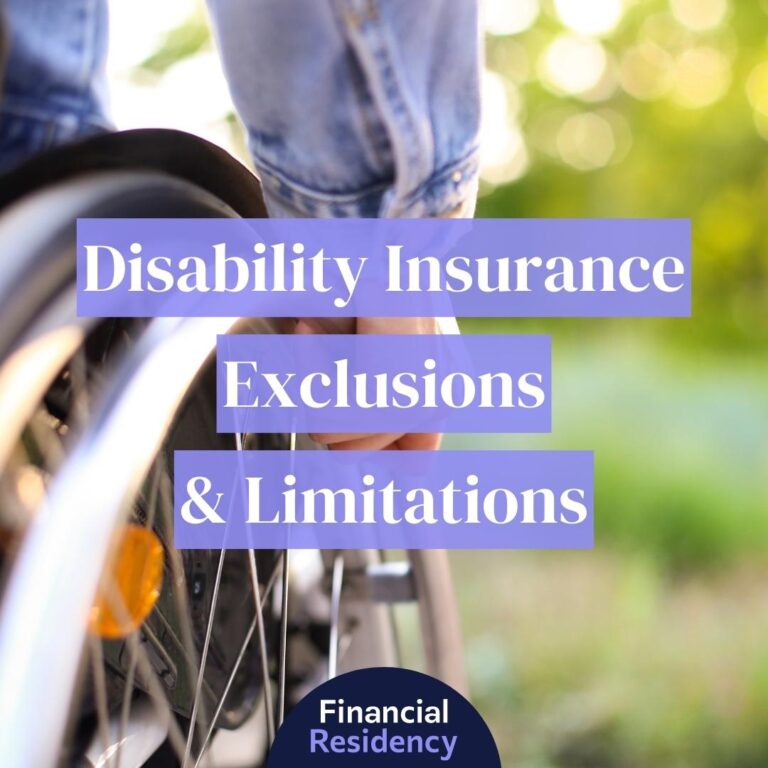Disability insurance is a good idea for physicians and dentists, who may have incurred hundreds of thousands of dollars in student loans to pursue their chosen career field.
If you get sick or injured, you still have to pay your medical school student loan debt along with your mortgage and other bills.
Disability insurance can cover these expenses in the event you can’t work, securing the financial future for you and your family.
Principal Insurance is one of the “Big 5” disability insurance companies that offer coverage for these types of scenarios.
Principal Financial Group: Overview
Principal Financial Group (PFG) is an insurance and investment management company headquartered in Des Moines, Iowa. Founded in 1879, PFG is one of the world’s largest insurance providers. It operates in North and South America, Europe, Asia, and Australia.
Principal offers its 33 million customers disability insurance, life insurance, and retirement savings options.
The company regularly receives excellent ratings for financial stability, leadership strength, and client satisfaction.
- BBB score: A+
- CEO: Daniel Joseph Houston
- Year founded: 1879
- Phone number: 1 (800) 986-3343
- Services offered: health insurance, disability insurance, life insurance, annuities, and retirement planning and investment
- A.M. Best score: A+
Principal Disability Insurance: Fast Facts
Here are a few fast facts about Principal disability insurance.
- Eligibility requirements: Age 18-60 (older ages may be approved with individual review and underwriting) all occupation classes, medical exam likely required, no pre-existing conditions (although they may be allowed with specific exclusion underwriting).
- Benefit periods: 2 years, 5 years, age 65, age 67, or age 70
- Premium costs: Typically 1 to 5 percent of the insured party’s annual income. Varies based on age, sex, occupation class, elimination period, and optional benefits or riders.
- Maximum benefit: $30,000 per month or up to $35,000 per month participation limit with other Principal insurance.
- Elimination period: 60 days, 90 days, 180 days, or 365 days
- Discounts: 10 percent affiliate discount or up to 20 percent multi-life discount.
Principal Disability Insurance: Definition of Disability
A good disability insurance plan will have a more flexible definition of what constitutes a disability. Unfavorable plans instead have a very narrow scope.
No matter how sick or injured you may be, if you can’t meet the plan’s definition you won’t be able to collect — even if you’re medically unable to work or have paid thousands of dollars in monthly premiums.
When examining disability claims, there are three main definitions that insurance companies use:
- Any occupation
- Own-occupation, not working
- True own-occupation
Any Occupation
To collect benefits for any occupation disability, you must be ill or injured in a way that prevents you from working any job in any capacity.
For physicians, this is the worst definition of disability. If you are a surgeon and have a hand injury that prevents you from performing medicine, but you are still able to do other work — hospital billing, bagging groceries, sweeping streets — then you would not be able to collect any disability benefits.
Own-occupation, Not Working
This definition of disability is less rigid than any occupation, but a little bit more complicated. Different insurance carriers have their own definition of “Own-Occupation, Not Working.”
Principal defines “Own-Occupation, Not Working” as being unable to work in your current job and choosing to not work in another job.
True Own Occupation
A true-own occupation disability policy allows you to collect disability benefits if you are not able to perform some, part, or all of your current job duties because of an illness or injury.
Principal uses this definition for a true-own occupation disability, with the added language, “There must be no reasonable job or worksite modifications which will enable you to do your own occupation.”
For physicians, true-own occupation is the preferred definition of disability as it’s the most comprehensive and has the easiest standard to meet. So if you are no longer able to perform surgery (even with reasonable accommodations) but still have the ability to work you would still qualify for disability insurance and be able to collect benefits.
To receive this type of coverage, you would need to opt for a more comprehensive disability insurance plan and add this definition by attaching a Regular Occupation rider.
Principal Disability Insurance: Built-in Benefits
Any Principal disability insurance policy comes with some attractive built-in benefits. These extras are standard to every policy and do not add to the cost of your monthly premium.
Death Benefit
If available in your state, this benefit pays out one lump sum benefit of three times the disability benefit if the policyholder dies while disability benefits are being paid after the elimination period.
The elimination period is the period of time from the onset of an illness or injury until the policyholder begins to receive disability benefits.
Waiver of Premium
Once you begin collecting any disability benefits, you don’t have to pay any monthly premiums. After you resume work, you would need to resume your disability premium payments to recommence coverage.
Interrupted Elimination Period
This benefit offers you flexibility with how the elimination period is satisfied; it can be broken up into smaller separate periods.
As an example, if you had a 90-day elimination period, you could satisfy it for 30 consecutive days now and then two additional periods of 30 consecutive days at future points in time. You would not have to wait 90 consecutive days in a row.
Recurring Disability Benefit
With this benefit, you would not have to wait a second or third elimination period if the same condition is causing you to collect disability benefits and you have previously satisfied the elimination period for this illness or injury.
Riders
Principal offers a number of free (no-cost) and paid disability insurance riders in addition to the built-in benefits covered in the previous section.
Presumptive Disability Benefit Rider
Policyholders will receive $5,000 a month if they permanently lose hearing in both ears, sight in both eyes, speech ability, use of both hands or of both feet, or the combination of one hand and one foot.
Benefits accrue from the date the presumptive disability occurs and will continue to be paid as long as the loss impacts your ability to work. Benefits are paid until the end of the benefit period for as long as the duration of the loss, or if the benefit period is through age 65 or older, then the benefit would be extended through the policyholder’s lifetime.
Short-term Residual Disability Benefit Rider
This enables a policyholder to collect a portion of their benefits if they are not able to return to work full-time. For Principal, this requires a loss of income of 20 percent or greater.
Supplemental Health Benefit Rider
The policyholder can receive a once-in-lifetime lump sum benefit of $30,000 if you become disabled as defined by your specific policy and are diagnosed with cancer, stroke, or other qualifying critical illnesses.
Benefit Update Rider
This rider enables you to increase your insurance coverage as your income grows without any predefined cap, ; however, you could only increase your coverage once every three years unless you had utilized a one-time advanced benefit update request.
If you use that one-time benefit, you cannot use your three-year benefit cap increase and would need to wait six more years before increasing your benefits.
Residual Disability and Recovery Benefit Rider
With this rider, you can be paid a percentage of your monthly benefit even if you are not 100 percent disabled or unable to work. You can also earn some benefits if your income was reduced because you worked in another occupation outside of your “regular occupation.”
Catastrophic Disability Rider
In the event of catastrophic disability, Principal offers additional monthly benefits. To meet the definition of catastrophic disability, that means you are unable to perform two or more basic daily functions including eating, bathing, dressing, or using the toilet.
Conditionally Renewable Policy Rider
This rider ensures that you can continue to renew your Principal insurance policy annually for the rest of your life — provided you continue to work full-time and to meet other policy requirements. As long as the requirements are met, Principal cannot cancel or modify it.
Cost of Living Adjustment (COLA) Rider
A COLA rider means that your benefits will increase yearly (on your anniversary date) to keep pace with inflation. In the event you become disabled or reliant on disability benefits, the COLA rider may be vital to ensuring you can continue to meet your monthly financial obligations.
Extended Total Disability Benefit Rider
This rider enables you to extend that maximum benefit period, as long as you are employed at the start of your disability, or you are receiving benefits under the rider for presumptive disability benefits.
A presumptive disability presumes a disability so severe that only a total disability can be presumed. This may include conditions like total blindness, profound mental deficiency or impairment, or amputation of both legs at the hip.
Premiums
A host of factors dictate the cost of your disability insurance premiums. For physicians and medical professionals, these are the inputs that Principal looks at when determining the cost of disability insurance premiums:
- Annual work income (pre-tax)
- Other sources of annual income
- Estimated monthly expenses
- Age
- Sex
- State of residence
- Any employer disability group coverage
- Occupation class
- Job role
- Preexisting conditions
For example, a 30-year-old male physician in Montana earning $200K a year could pay 20 percent more for basic insurance premiums than the same policyholder in Illinois. However, he could pay 24 percent less for comprehensive coverage, paying $220 a month in premiums in Montana vs $295 a month in Illinois.
For sex, there’s even more disparity in premium costs. Women can expect to pay 40 to 75 percent more for coverage than men — even women past childbearing years which insurance companies define as age 15 to 44.
Alternatives
Here are some great alternatives for disability insurance for physicians:
Guardian
Guardian has the most inclusive definition of “total disability.”
They provide coverage if you work in a different medical specialty than the one you went to med school for. Even if you can work in another field, Guardian will still pay your benefits in full.
MassMutual
MassMutual has perhaps the most generous Cost of Living Adjustment (COLA) rider which provides a guaranteed increase to your benefits every year. By year six, the COLA rider will increase its payout by 16 percent.
On the flip side, Mass Mutal has a very narrow definition of own-occupation disability. If you are employable in some capacity, Mass Mutal will not pay your benefits in full.
Ameritas
Ameritas has a generous definition of own-occupation disability.
Your field of specialization is considered to be your own occupation, thus if you work outside of your regular occupation (i.e., you switch from dermatology to family medicine) after your disability event Ameritas will pay your benefits in full.
The Standard
The Standard typically offers the best coverage options for applicants over age 60.
Policyholders can receive benefits if they are away from work in order to care for a family member with a serious health condition, and it also offers a more comprehensive enhanced residual disability benefit.
The Standard also provides rehabilitation benefits to help clients return to work.
Pros and Cons
Here are some pros and cons of disability insurance with Principal Financial Group:
Pros:
- Flexible definitions of disability: Principal includes “Total Disability While Working (True-Own occupation). The definition for your policy depends on the level of coverage you select.
- Automatica increases: Annual increase (AI) rider offers a 3 percent automatic benefit increase each year on your policy’s anniversary date.
- Flexible distribution periods: You can choose from a wide variety of benefit distribution periods, including two years, five years, or age-based (until age 65, 67, or 70).
- Generous payout benefits: Principal offers up to $30K per month, or $35K per month in limited scenarios.
- Reputation: Principal has a longstanding reputation in the insurance industry as a Fortune 500 and global investment firm leader with high BBB and A.M. Best ratings.
Cons:
- Limited geographic availability: The Principal Income Protector policy is not available to policyholders residing in CA, FL, MT, NY, ND, SC, SD, or WY. Principal does have disability insurance products available in all 50 states, however, some offerings are limited.
- Use it or lose it: You could lose your Future Purchase Option (FPO) rider if you decline your AI increase for two years in a row — this, in turn, could terminate your MYB rider.
- High premiums: Principal does offer outstanding coverage — with better income protection and benefits than most plans — but it comes at a higher cost than many other disability coverage options.
Frequently Asked Questions
How do you get a Principal disability insurance quote?
You can get a free Principal disability insurance quote online It only takes 3-5 minutes to apply for a quote, during which you’ll enter some basic details about your income, expenses, profession, health, and age.
After, you’ll be asked if you wish to download the information to provide to your financial planner or if to be contacted by a representative from Principal Financial Group.
Is Principal Insurance a good company?
Principal Insurance is a leading insurer, securing high ratings for its financial strength and customer service. It’s one of the largest and most formidable life insurance companies in the industry and ranks among the “Big 5” companies offering true own-occupation disability insurance for doctors and dentists.
What is the best health insurance for disability?
For physicians, dentists, and medical professionals, the best disability insurance coverage comes from one of the “Big 5” carriers: Principal, Guardian, The Standard, Ameritas, or MassMutual. These five providers are the only ones to provide true-own occupation disability insurance.
Why are most disability claims denied?
Lack of adequate medical evidence to support a disability claim is a common reason that SSDI (Social Security disability insurance) claims are denied.
Disability claims are also commonly denied if they are based on a condition or symptom for which you received treatment during an exclusion period listed on your policy (it’s determined to be a pre-existing condition). Additionally, a claim may be denied if a reviewer finds that your non-treated condition is the one you should have reasonably pursued treatment for.
Why is disability insurance the most overlooked form of coverage?
Disability insurance is often overlooked because:
- People don’t understand how it works or what constitutes a disability
- People don’t realize that one-third of working Americans will become unable to work at some point.
- People think their SSDI coverage is sufficient
- People don’t realize how critical disability insurance is
At what age should you drop disability insurance?
Age 65 may be the right time to drop disability insurance coverage. This is because disability insurance protects your ability to earn income, but once you reach retirement, you would no longer be working. Additionally, benefits typically stop when you turn 65.
Note that for some Principal disability insurance plans, the policyholder may have coverage until age 67 or 70.
Bottom Line
Principal is a solid disability insurance choice for doctors and other medical professionals. It’s also one of only six insurance carriers to offer a true own-occupation definition of disability.
Up until age 65, Principal offers continued, guaranteed coverage that is renewable and noncancellable, regardless of any change in occupation, salary, or health.
Additionally, Principal comes with a host of built-in benefits and optional riders to increase and customize the coverage options you need. While Principal is available in all 50 states, there are limited disability insurance product offerings in California, Florida, Montana, New York, South Carolina, South Dakota, and Wyoming.
Regardless of your state of residence, as one of the “Big 5” providers, Principal deserves strong consideration on your list of disability insurance coverage options.




